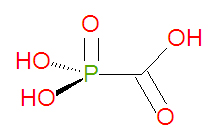Foscarnet: Difference between revisions
imported>David E. Volk (stub, more coming don't delete) |
imported>David E. Volk No edit summary |
||
| Line 1: | Line 1: | ||
{{subpages}} | {{subpages}} | ||
'''Foscarnet''' is a | |||
{{Chem infobox | |||
|align=right | |||
|image=[[Image:Foscarnet.jpg|center|thumb|220px]] | |||
|width=200px | |||
|molname=foscarnet | |||
|synonyms= see list below | |||
|molformula= CH<sub>3</sub>O<sub>5</sub>P | |||
|molmass= 126.0053 | |||
|uses=treatment of CMV retinitis, herpes and HIV. | |||
|properties= antiviral agent | |||
|hazards=see drug interactions | |||
|iupac= phosphonoformic acid | |||
|casnumber=63585-09-1 | |||
}} | |||
'''Foscarnet''' is an [[antiviral drug]] used to treat retinitis due to cytomegalovirus (CMV) and acyclovir-resistant [[herpes simplex virus]] (HSV-1 & HSV-2) infections in patients with compromised immune systems, often associated with [[AIDS]]. | |||
== Chemistry == | |||
Foscarnet is a [[carboxylic acid]]-based organic mimic of the natural inorganic compound [[pyrophosphate]]. The chemical name of foscarnet is phosphonoformic acid and it has chemical formula CH<sub>3</sub>O<sub>5</sub>P, giving it a molecular mass of 126.0053 g/mol. Being already phosphorylated, foscarnet does not need to be phosphorylated to become active. Becuase of this, viral strains resistant to [[acyclovir]] or [[ganciclovir]], associated with thymidine kinase deficiency, may be treatable with foscarnet. Foscarnet and related compounds, like [[phosphonoacetic acid]] (PAA), can be synthesized by reacting chloroformic acid esters with phosphites ([the [Arbuzov reaction]])<ref>{{cite journal| author = Noren, Helgstrand, Johansson, Misiorny and Stening | journal = J. Med. Chem. | volume = 26 | pages = 264-270}}[http://pubs.acs.org/cgi-bin/archive.cgi/jmcmar/1983/26/i02/pdf/jm00356a028.pdf]</ref> | |||
== Mechanism of action == | |||
Foscarnet binds to pyrophosphate binding sites of DNA polymerases and thus inhibits the production of viral DNA by blocking the energy source (pyrophosphate) from reaching the viral polymerases. Cellular DNA polymerases are not effected by the dosages at foscarnet is taken. | |||
== Synonyms and brand names == | |||
''Synonyms'' | |||
* PFA | |||
* Foscarnet sodium | |||
* Forscarnet sodium | |||
* Dihydroxyphosphinecarboxylic acid oxide | |||
* Carboxyphosphonic acid | |||
* Phgosphonocarboxylic acid | |||
* Phosphonoformate | |||
* Phosphonoformic acid | |||
''Brand names'' | |||
* Foscarmet® | |||
* Foscavir® | |||
* Triapten® | |||
Revision as of 14:08, 28 March 2008
|
| |||||||
| foscarnet | |||||||
| |||||||
| Uses: | treatment of CMV retinitis, herpes and HIV. | ||||||
| Properties: | antiviral agent | ||||||
| Hazards: | see drug interactions | ||||||
| |||||||
Foscarnet is an antiviral drug used to treat retinitis due to cytomegalovirus (CMV) and acyclovir-resistant herpes simplex virus (HSV-1 & HSV-2) infections in patients with compromised immune systems, often associated with AIDS.
Chemistry
Foscarnet is a carboxylic acid-based organic mimic of the natural inorganic compound pyrophosphate. The chemical name of foscarnet is phosphonoformic acid and it has chemical formula CH3O5P, giving it a molecular mass of 126.0053 g/mol. Being already phosphorylated, foscarnet does not need to be phosphorylated to become active. Becuase of this, viral strains resistant to acyclovir or ganciclovir, associated with thymidine kinase deficiency, may be treatable with foscarnet. Foscarnet and related compounds, like phosphonoacetic acid (PAA), can be synthesized by reacting chloroformic acid esters with phosphites ([the [Arbuzov reaction]])[1]
Mechanism of action
Foscarnet binds to pyrophosphate binding sites of DNA polymerases and thus inhibits the production of viral DNA by blocking the energy source (pyrophosphate) from reaching the viral polymerases. Cellular DNA polymerases are not effected by the dosages at foscarnet is taken.
Synonyms and brand names
Synonyms
- PFA
- Foscarnet sodium
- Forscarnet sodium
- Dihydroxyphosphinecarboxylic acid oxide
- Carboxyphosphonic acid
- Phgosphonocarboxylic acid
- Phosphonoformate
- Phosphonoformic acid
Brand names
- Foscarmet®
- Foscavir®
- Triapten®
